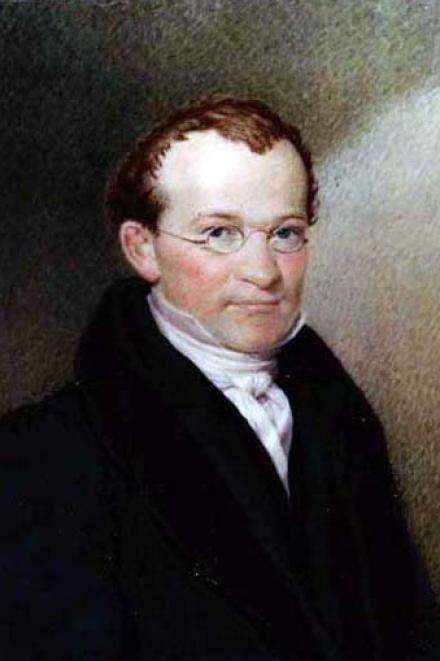
Christopher Columbus Baldwin was librarian of the American Antiquarian Society from 1827 to 1835.(1) He followed in the footsteps of Isaiah Thomas, the Society's founder, by adding substantially to the collection. Baldwin was relentless in writing to prominent authors and publishers to ask for copies of their work. His diary account of the 1834 acquisition of Thomas Wallcut's personal library of New England imprints demonstrated his dedication as a collector. Baldwin described packing over 4,400 pounds of bound volumes, loose pamphlets, newspapers, and manuscripts. He found them 'in ancient trunks, bureaus, and chests, baskets, tea chests and old drawers, and [they] presented a very odd appearance. The extent of them was altogether beyond my expectations.... Every thing was covered with venerable dust, and as I was under a slated roof and the thermometer at ninety-three, I had a pretty hot time of it. Nothing but a love of such work could inspire any man to labor in such a place. The value of the rarities I found, however, soon made me forget the heat, and I have never seen such happy moments.'(2)
An indefatigable collector, he described his philosophy in a letter to a colleague in 1834, 'My daily experience tells me that we cannot determine what is valuable and what is not. There is scarcely anything that issues from the press that will not be wanted by somebody.'(3) Not only did Baldwin acquire these materials, he spent much of his time preparing the first catalogue of the Society's collections.
Before accepting the post at the American Antiquarian Society, Baldwin had studied at Harvard (from which he was rusticated) and practiced law in Barre and Sutton, Massachusetts. With his friend William Lincoln (1801-43), he published the Worcester Magazine and Historical Journal and later edited the National Aegis. He kept a diary from 1829 to 1835; in it are detailed descriptions of both his professional and social lives. Baldwin also used his diary as a place to record the corporate activities of the American Antiquarian Society, to which he was elected a member in 1827.
Baldwin was the Society's only full-time employee. He was responsible for the planting of over 500 trees on the grounds in 1834, noting in his diary that 'I have dug them up in the woods and brought them on my back. . . They will afford a comfortable shade for my successor, if I should not live to enjoy it myself.'(4) Alas, he did not.
The next year, Baldwin was sent by the Society's Council to investigate ancient burial mounds in southern Ohio. The last entry in his diary, noted on Thursday, August 20, 1835, was, 'Start by stage on the Cumberland road for Zanesville.'(5) En route, the carriage overturned and he was killed. He was thirty-five years old.
Shortly before Baldwin departed for the West, Sarah Goodridge painted this miniature. She has been called America's finest woman miniaturist.(6) In her own day, Goodridge's miniatures were highly regarded for their accuracy of likeness. Her portrait of Baldwin was the 'exact miniature' used as a reference for the full-sized canvas painting of the sitter painted posthumously by Chester Harding for the American Antiquarian Society in 1835.(7) At the time, the miniature was still owned by the family but was lent to Harding. The miniature descended in the family until it was given to the Society in 1907 by Baldwin's niece.
Harding, who was commissioned to copy the miniature two months after Baldwin's death, was the most sought-after portrait painter in Boston. He and Baldwin had been acquainted for several years, having met at a dinner party in 1829. Harding is mentioned in the young librarian's diaries several times after their initial meeting.(8) Baldwin's friend, William Lincoln, described the Society's satisfaction with the portrait. 'The Council...[has] procured a portrait by the celebrated painter Harding, from an exact miniature of Mr. Baldwin; that the living image of an associate so valued and a friend so loved may remain in our halls, as his memory will continue in the hearts of those who knew his worth and the ardor of his enthusiasm in those pursuits to which our institution has been dedicated.'(9)
1) Baldwin took a leave of absence in 1831-32, during which time Samuel Burnside served as acting librarian.
2) Christopher Columbus Baldwin Diary, August 2 1834, reprinted in Nathaniel Paine, ed., Diary of Christopher Columbus Baldwin, (Worcester: American Antiquarian Society, 1901): 317-18.
3) Christopher Columbus Baldwin to the Reverend John Pierpont, March 1834, Christopher Columbus Baldwin Papers, 1817-1835, American Antiquarian Society Manuscript Collection.
4) Christopher Columbus Baldwin Diary, April 19, 1834, reprinted in Nathaniel Paine, ed., Diary of Christopher Columbus Baldwin, (Worcester: American Antiquarian Society, 1901): 292.
5) Christopher Columbus Baldwin Diary, August 20, 1835, reprinted in Nathaniel Paine, ed., Diary of Christopher Columbus Baldwin, (Worcester: American Antiquarian Society, 1901): 364.
6) Dale T. Johnson, American Portrait Miniatures in the Manney Collection (New York: Metropolitan Museum of Art, 1990): 125.
7) May 1836, Proceedings of the American Antiquarian Society, 1812-1849, 329.
8) Diary of Christopher Columbus Baldwin, August 23, 1829, Christopher Columbus Baldwin Papers 1817-1835, American Antiquarian Society Manuscript Collection.
9) May 25, 1836, Proceedings of the American Antiquarian Society, 329.
Worcester, MA
United States